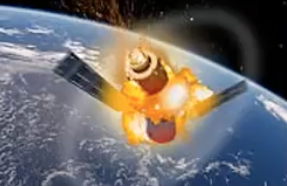No Joke ... Chinese Space Station, Heavenly Palace, Could Crash to Earth on April 1, But Where?
An out-of-control Chinese space station hurtling towards our planet could crash land on April Fool’s Day — and that is not a joke. But when will Tiangong-1 fall to earth exactly? Where will it crash?
Space experts say the huge eight-and-a-half tonne mass, which is heavier than an African elephant, could hit a populated area in a worst-case scenario as it starts its fiery ascent into the Earth’s atmosphere.

, also known as Heavenly Palace, vanished from its Chinese creators’ monitors in March 2016 but has since been relocated.
It is now being “closely monitored” by the Aerospace Corporation’s Centre for Orbital and Debris Reentry Studies (CORDS) which tracks space debris for collision avoidance.
The European Space Agency (ESA) has said crash date estimates are ‘highly variable’ at present but scientists are giving revised forecasts on the free-falling space station every couple of days.
The crash window has been narrowed down to March 30 and April 3, with the most likely date being April 1.
Experts say the satellite has the highest chance of smashing into a narrow strip around latitudes of 43 degrees north and south.
Mass-populated cities including New York, Michigan, Barcelona, Beijing, Rome and Toronto are all at risk if this happens.
While the space station measures 34 feet long and 11 feet in diameter, much of the spacecraft will burn up upon re-entry leaving the rest to fall as debris.
Aerospace Corporation has played down fears, saying the fragments are most likely to fall into the ocean with the chance of a person being hit less than one in 1,000,000,000,000.
It said: "When considering the worst-case location, the probability that a specific person will be struck by Tiangong-1 debris is about one million times smaller than the odds of winning the Powerball jackpot.
"In the history of spaceflight, no known person has ever been harmed by re-entering space debris.
"Only one person has ever been recorded as being hit by a piece of space debris and, fortunately, she was not injured."
Are there any other dangers?
Aerospace has confirmed that the “highly toxic and corrosive substance” hydrazine is on board Tiangong-1
If exposed to humans, the rocket fuel can cause nausea and seizures, as well as cancer in the long-term.
When did Chinese space station Tiangong-1 launch?
Tiangong-1 launched without any passengers on September 29, 2011, weighing 18,740 pounds. Two manned missions by Chinese astronauts were completed in 2012 and 2013 before it went missing.
China reported to the United Nations that telemetry services with Tiangong-1 had “ceased functioning” on March 16, 2016.
The battle to track it before it causes destruction on earth has been on since.
Shaanxi Probecom Microwave Technology Co.,LTD (abbreviated as Probecom), was founded in 2002, located in International Trade and Logistic Park in Xi’an, we are mainly engaged in the design and manufacture of all types of satellite communication Earth Station Antenna, VSAT Antenna, Ka Series Antenna, Portable Flyaway Antenna, RxO/TVRO Antenna, SNG Antenna, On-the-Move Antenna, Remote Sensing & Telemetry Antenna, Meteorological Radars, High Power and Ultra Wideband Amplifiers (SSPA & TWTA), Microwave Components as well as the related Antenna Control & Tracking System.

